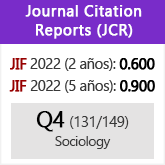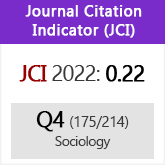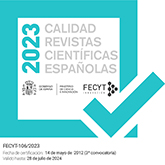La calidad de la respuesta en la encuesta presencial. El caso de los barómetros del Centro de Investigaciones Sociológicas
DOI:
https://doi.org/10.3989/ris.2015.73.3.e022Palabras clave:
Encuestas presenciales, Entrevistadores, No respuesta parcialResumen
La entrevista cara a cara con cuestionario estructurado ha sido la modalidad de recogida de información más utilizada en España hasta finales del siglo XX. La realización de la entrevista a solas con el entrevistado, al ritmo fijado por este y empleando adecuadamente recursos visuales (tarjetas) que ayudan a la comprensión de la pregunta, genera que los cuestionarios respondidos mediante esta modalidad presenten un escaso número de preguntas no respondidas. El objetivo de este trabajo es cuestionar esta afirmación considerando, por un lado, las declaraciones del entrevistador (que definen la situación en la que ha tenido lugar la entrevista) y, por otro, la ausencia de valores en las variables (consecuencia de lo anterior). Los entrevistadores señalan que en el 14 % de los hogares las entrevistas se realizaron en compañía, un 10 % de los entrevistados ha tenido prisa por terminar la entrevista y el 21 % respondió el cuestionario sin ayudas visuales. En cuanto a la no respuesta parcial, el porcentaje medio obtenido por las categorías «no sabe» y «no responde» es superior al 6 % en cuatro de los seis estudios considerados. Estas «ausencias de respuesta» aumentan notablemente cuando los entrevistados no emplean las tarjetas y en las entrevistas realizadas con prisa.
Descargas
Citas
Asociación Española de Estudios de Mercado, Marketing y Opinión (Aedemo). 2014. El sector de la investigación en España 2013 [http://www.aedemo.es/aedemo/images/stories/estudio_industria/2014_AVANCE_ESTUDIO_DEL_SECTOR_DE_LA_INVESTIGACION_2013.pdf]. Acceso 9 de octubre 2014.
Asociación Española de Estudios de Mercado, Marketing y Opinión (Aedemo). Varios a-os. El sector de la investigación de mercados en España. Consulta el 15 de mayo de 2014 (http://www.aedemo.es/aedemo/index.php?option=com_content&task=blogcategory&id=37&Itemid=207).
Benthlehem, Jelke y Silvia Biffignandi. 2012. Handbook of web surveys. Nueva York: Wiley.
Boeije, H. R. 2004. "And then there were three: self-presentational styles and the presence of the partner as a third person in the interview". Field Methods 16:3-22. http://dx.doi.org/10.1177/1525822X03259228
Bourque, Linda B. y Virginia A. Clark. 1992. "Processing Data: The Survey Example". Paper Series on Quantitative Applications in the Social Sciences 07-085. Sage University, Newbury Park, CA.
Centro de Investigaciones Sociológicas. 2011a. Normas generales para la correcta aplicación del cuestionario. Madrid: CIS. (Sin publicar).
Centro de Investigaciones Sociológicas. 2011b. Barómetros del primer semestre del a-o 2011. Madrid: Centro de Investigaciones Sociológicas 2477; 2481; 2483; 2508; 2511 y 2528.
Centro de Investigaciones Sociológicas. 2014. Barómetros del segundo trimestre del a-o 2014. Madrid: Centro de Investigaciones Sociológicas 3021; 3024 y 3033.
Converse, Philip E. 1964. "The nature of belief systems in mass publics". Pp. 154-178 en Ideology and Discontent, editado por David E. Apter. Nueva York: Free Press.
Couper, Mick P. 2011. "The future of modes of data collection". Public Opinion Quarterly 75:889-908. http://dx.doi.org/10.1093/poq/nfr046
Davis, Darren W. y Brian D. Silver 2003. "Stereotype Threat and Race of Interviewer Effects in a Survey on Political Knowledge". American Journal of Political Science 47:33-45. http://dx.doi.org/10.1111/1540-5907.00003
Díaz de Rada, V. 2015. Manual de trabajo en la encuesta. Madrid: CIS.
Flores-Macias, Francisco y Chappel Lawson. 2008. "Effects of Interviewer Gender on Survey Responses: Findings From a Household Survey in Mexico". International Journal of Public Opinion Research 20:100-110. http://dx.doi.org/10.1093/ijpor/edn007
Groves, Robert M. 1989. Survey error and survey cost. Nueva York: Wiley. http://dx.doi.org/10.1002/0471725277
Groves, R. M., F. J. Fowler, M. P. Couper, J. M. Lepkowski, E. Singer y R. Tourangeau. 2009. Survey Methodology. Nueva York: Wiley.
Groves, Robert M. & Lars Lyberg. 2010. "Total Survey Error: past, present and future". Public Opinion Quarterly 74:849-879. http://dx.doi.org/10.1093/poq/nfq065
Groves, Robert M. y Mick P. Couper. 1998. Nonresponse en Houlsehold Interview Surveys. Nueva York: Wiley. http://dx.doi.org/10.1002/9781118490082
Karp, Jeffrey A. y D. Brockington. 2005. "Social Desirability and Response Validity: A Comparative Analysis of Over-Reporting Voter Turnout in Five Countries". The Journal of Politics 67:825-840. http://dx.doi.org/10.1111/j.1468-2508.2005.00341.x
Kish, Leslie. 1965. Survey Sampling. Nueva York: Wiley.
Krosnick, Jon A. 1991. "Response strategies for coping with the cognitive demands of attitude measures in surveys". Applied Cognitive Psychology 5:213-236. http://dx.doi.org/10.1002/acp.2350050305
Krosnick, Jon A. 1999. "Survey research". Annual Review of Psychology 50:537-567. http://dx.doi.org/10.1146/annurev.psych.50.1.537 PMid:15012463
Lavrakas, Paul J. 2008. "Surveys by telephone". Pp. 249-261 en The SAGE Handbook of Public Opinion Research, editado por W. Donsbach y M. W. Traugott. Thousand-Oaks, LA: Sage.
(De) Leeuw, Edith 2008. "Choosing the method of data collection". Pp. 113-135 en International Handbook of Survey Methodology, editado por E. de Leeuw, J. J. Hox y D. A. Dillman. Nueva York: Lawrence Erlbaum Associates y Asociación Europea de Metodología.
Low, Jacqueline. 2012. "Conflict or concert? Extending the simmelian triad to account for positive third party presence in face-to-face interviews with people living with Parkinson's disease". Societies 2:210-221. http://dx.doi.org/10.3390/soc2030210
National Centre for Social Research. 1999. How to Improve Survey Response Rates. A guide for Interviewers on the Doorstep (vídeo). Londres: Sage.
Nú-ez Villuendas, Adoración. 2005. "Incidencias de la entrevista personal en la investigación por encuesta". Revista Española de Investigaciones Sociológicas 109:219-236. http://dx.doi.org/10.2307/40184672
Revilla, Melanie A., Willem E. Saris y Jon A. Krosnick. 2014. "Choosing the Number of Categories in Agree-Disagree Scales". Sociological Methods & Research 43:73-97. http://dx.doi.org/10.1177/0049124113509605
Riba, Clara, Mariano Torcal y Laura Morales. 2010. "Estrategias para aumentar la tasa de respuesta y los resultados de la Encuesta Social Europea en España". Revista Internacional de Sociología 68:603-635. http://dx.doi.org/10.3989/ris.2008.12.17
Roth, Philip L. 1994. "Missing Data: A Conceptual Review for Applied Psychologists". Personel Psychology 47:537-560. http://dx.doi.org/10.1111/j.1744-6570.1994.tb01736.x
Schaeffer, Nora Cate, Jeniffer Dykema y Douglas W. Maynard. 2010. Pp. 473-470 en Handbook of Survey Research, editado por P. V. Marsden y J. D. Wright. Bingley, UK: Emerald Group Publishing Limited.
Smith, Tom et al. 1998. "Identifying underlying dimensions in spouses evaluation of fairness in the division of household labor". International Social Science Research 27:305-327. http://dx.doi.org/10.1006/ssre.1998.0624
Smith, Tom. 1997. "The impact of the presence of others on a respondent's answers to question". International Journal of Public Opinion Research 9:33-47. http://dx.doi.org/10.1093/ijpor/9.1.33
Stoop, Inkele, Jaak Billiet, Achim Koch y Rory Fitzgerald. 2010. Improving survey response: lessons learned from the European Social Survey. Nueva York: Wiley. http://dx.doi.org/10.1002/9780470688335
Streb, Matthew J. et al. 2008. "Social Desirability Effects and Support for a Female American President". Public Opinion Quarterly 72:76-89. http://dx.doi.org/10.1093/poq/nfm035
Survey Research Center. 1976. Interviewer's Manual: Survey Research Center. Ann Arbor: Institute for Social Research, Universidad de Michigan.
Survey Research Laboratory, University of Illinois. 1994. General Training Manual for Face-to-Face Interviewers. Chicago, Illinois: Universidad de Illinois.
Tabachnick, Barbara G. y S. Fidell Linda. 1989. Using Multivariate Statistics. Nueva York: Harper & Publishers.
Taylor, Bridget y Hilde de Vocht. 2011. "Interviewing separately or as couples? Considerations of authenticity of method". Qualitative Health Research 21:1576-1587. http://dx.doi.org/10.1177/1049732311415288 PMid:21737568
Tourangeau, Roger y Norman M. Bradburn. 2010. "The Psychology of survey response". Pp. 315-346 en Handbook of Survey Research, editado por P. V. Marsden y J. D. Wright. Bingley, UK: Emerald Group Publishing Limited.
Tourangeau, Rogert, Frederic G. Conrad y Mick P. Couper. 2013. The Science of Web Surveys. Oxford: Oxford University Press. http://dx.doi.org/10.1093/acprof:oso/9780199747047.001.0001
Zipp, John F. y Eric Plutzer. 1996. "Wives and husbands: social class, gender and class identification in the US". Sociology 30:235-52. http://dx.doi.org/10.1177/0038038596030002003
Zipp, J. F. y J. Toth. 2002. "She said, he said, they said: The impact of spousal presence in survey research". Public Opinion Quarterly 66:177-208. http://dx.doi.org/10.1086/340028
Publicado
Cómo citar
Número
Sección
Licencia
Derechos de autor 2015 Consejo Superior de Investigaciones Científicas (CSIC)

Esta obra está bajo una licencia internacional Creative Commons Atribución 4.0.
© CSIC. Los originales publicados en las ediciones impresa y electrónica de esta Revista son propiedad del Consejo Superior de Investigaciones Científicas, siendo necesario citar la procedencia en cualquier reproducción parcial o total.Salvo indicación contraria, todos los contenidos de la edición electrónica se distribuyen bajo una licencia de uso y distribución “Creative Commons Reconocimiento 4.0 Internacional ” (CC BY 4.0). Puede consultar desde aquí la versión informativa y el texto legal de la licencia. Esta circunstancia ha de hacerse constar expresamente de esta forma cuando sea necesario.
No se autoriza el depósito en repositorios, páginas web personales o similares de cualquier otra versión distinta a la publicada por el editor.

















